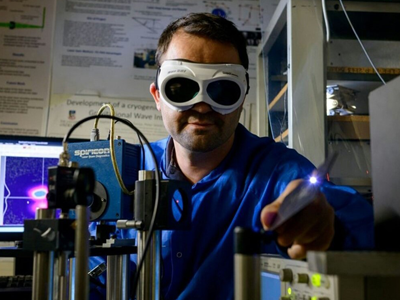Future is bright for this laser research

Physicists Dr Miftar Ganija and Dr Keiron Boyd are leading an exciting laser research program for Defence.
The DSTG-University of Adelaide program is developing lasers that can transmit ultra-short pulses of high-energy light. These lasers (known as ultrashort and short pulsed lasers (USPL)) are orders of magnitude more powerful than standard lasers and capable of vaporising or liquidising objects.
The ultrashort laser pulses are as brief as a quadrillionth of a second and 100 trillion times brighter than sunlight.
When shined onto a material, these laser bursts create extremely high temperatures and pressures that turn the material into plasma, the fourth state of matter. These conditions are normally only found at the heart of an explosion of thousands of tons of TNT or small nuclear bombs. Importantly, the brief laser pulses do not cause the target material's temperature to increase.
"The scope of USPL applications is expanding rapidly and requires new laser sources technology to enable them," says Dr Ganija. "The range of applications is very broad, encompassing industrial, scientific, medical, environmental, and sensing and defence. Some commentators predict that the 21st century will be the 'USPL century', mirroring the rapid growth in technology in the 20th century with the development of solid-state electronics."
Dual-use pathway to sovereign capability
According to Dr Ganija and Dr Boyd it is critical that Australia develops a sovereign USPL capability for Defence applications, in order to understand and counter current and emerging military threats associated with this laser technology.
"There is a shortage of USPL technology development and workforce in Australia," says Dr Ganija. "Our joint DSTG/University of Adelaide USPL team has identified a pathway to address these deficiencies through the 'dual-use' approach. This involves creating a sovereign eco-system in USPL industrial and science capability, thereby ensuring that we are in a position to address Defence's critical mid and long-term needs."
By systematically building and characterising USPL laser systems, the team is adding to our understanding of the physics of UPSL and the engineering required to develop UPSL systems. The current system employs cryogenic cooling and is leading the charge on the international stage, achieving impressive pulse and peak power energy levels.
Dr Ganija joined DSTG from the University of Adelaide, and supports research programs at both organisations through his position as DSTG-University of Adelaide Professor of USPL. "I am leading over a dozen researchers in the USPL program and support from DSTG has been critical to ensuring the continuity of my role, my research with the university and enabling me to inspire new students to the program," he says.
The current USPL program can be traced back 2014, when Miftar received funding through the University of Adelaide Institute for Photonics and Advanced Sensing (IPAS), headed at the time by Professor Tanya Monro (now Australia's Chief Defence Scientist). It was this pilot project that allowed Dr Ganija's work to flourish.
The University of Adelaide appointed Miftar as a Senior Research Fellow under the Beacon Research scheme, established to retain, attract and support mid-career researchers of outstanding research calibre and potential. Under this fellowship Miftar developed the platform for USPL and its dual-use applications, with further support from DSTG.
Educating laser physicists
"There is a world-wide shortage of scientists with expertise in the USPL technology and its applications, and this is perhaps the greatest threat to the realisation of the USPL potential and its commercialisation within Australia," says Dr Ganija.
"Education of highly qualified scientists and technologists in this field at postgraduate and postdoctoral levels will be driven by Defence imperatives. We also plan to increase industry partner engagement in the research, providing opportunities for up-skilling of the industry. Partner organisations will also have the opportunity to assess our researchers prior to offering them employment. A proposed USPL centre at the University of Adelaide will offer education and training for Defence personnel, allowing the centre to be Defence-oriented and support Defence needs."
Dr Ganija features in a DSTG Early Career Research video here.

